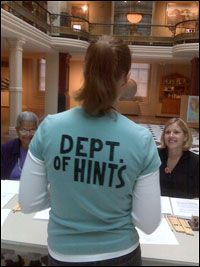Interactive Games Make Museums A Place To Play
 I caught this article on NPR’s Story of the Day podcast. Did anyone else get an eerie deja vu of Vox, the Artificial Intelligence museum guide from the 2002 version of the movie The Time Machine? Easy bonus points for the relevance of the lecturer’s name. 😉
I caught this article on NPR’s Story of the Day podcast. Did anyone else get an eerie deja vu of Vox, the Artificial Intelligence museum guide from the 2002 version of the movie The Time Machine? Easy bonus points for the relevance of the lecturer’s name. 😉
(NPR) All Things Considered, On a recent evening, 100 museum professionals gathered at the Newseum in Washington, D.C., to hear a lecture — not about funding, or curatorial responsibility — but about games. It’s time to “turn visitors into players,” Jane McGonigal told them.
McGonigal, who works for the Institute For The Future in Palo Alto, Calif., has been called the “guru of alternate reality games,” or ARGs. Millions of people play ARGs on their computers for several hours each week, and museum directors are looking to harness this enthusiasm to get people engaged with their collections.
Listen: [audio:http://www.arcane.org/media/01_Interactive_Games_Make_Museums_A.mp3]
What’s In A Game?
McGonigal says games make people happy — and she takes happiness very seriously. She’s come up with four elements she believes we all need to be happy: satisfying work, the experience of being good at something, time spent with people we like, and the chance to be a part of something bigger. Games, she says, do all of these things.
“Games work better than most of reality because they give us clear instructions. We know exactly what we’re supposed to do,” McGonigal says. “They give us better feedback; you can’t be good at something unless you’re getting feedback … Gamers don’t mind criticism.”
She says the shared experience of sharing a fictional narrative creates a sense of community among players — tapping into the need to be a part of something bigger.
3,300 Objects; 3,300 Stories
Fifty teenagers from New Jersey are practically running around a pristine Smithsonian gallery at the Luce Foundation Center for American Art in Washington, D.C. They’ve broken up into teams to play a multimedia scavenger hunt, in which objects in the collection are part of the clues, and players use cell phones with text messaging to solve them.
This game is a scaled down version of an experiment the Luce Foundation Center tried earlier this year: an alternate reality game called Ghosts of a Chance. For three months, players had to solve clues that were planted on Facebook, YouTube and other Web sites. Rather than advertise the game, the museum sent a tattooed bodybuilder to a conference for hard-core gamers.
“We think we’re the first museum in the world to host an alternate reality game,” says Georgina Goodlander of the Smithsonian’s Luce Foundation Center. “Alternate reality games have very distinctive narrative … The Luce Foundation Center has over 3,300 objects. We have 3,300 stories associated with those objects. So the idea of bringing in narrative and using it as a way of getting people to engage with the collection was fantastic.”
The game was designed for the museum by the company City Mystery. It revolved around restless spirits who were haunting the museum. The object of the game was to learn the stories of these spirits and put them to rest.
It’s unclear just how much museum gamers are actually learning about the art itself. One teenager said he liked the scavenger hunt because he got to see “a lot of art in a little bit of time.” But Goodlander isn’t worried about that at all.
“I think changing the mind-set — having them think about art museums in a more positive way — is our main goal,” she says.
Beth Merritt, head of the Center for the Future of Museums, believes that in 10 or 20 years, the best museums will be as interactive and fun as alternate reality games — for both kids and adults.
“Biologically, games are how we’re hard-wired to learn — that’s its evolutionary role,” Merritt says. “Why shouldn’t adults play games? It’s still the most effective way to learn and push our buttons to get information into our heads.”
Games Addressing Global Problems
Merritt is also excited about the possibilities for museum researchers. She points to McGonigal’s work using games to try and solve real world problems. Since millions of people are playing these games, McGonigal figures, why not harness that energy toward something that will benefit society?
One of the games McGonigal helped design was called World Without Oil. Nearly 2,000 people around the world played: they made videos, they blogged, they wrote research papers — all trying to solve the not-so-fictional oil crisis.
Now the Institute for the Future has created Superstruct, a game that asks people to imagine all kinds of different scenarios — from business, to the environment, to food — for the year 2019.
Some players are coming up with ideas for museums: one player in Amsterdam came up with The Museum of Impossible Things, where players would propose something impossible, and then people would come to the museum to try to create it.
McGonigal believes the ideas people imagine today are the keys to the planet’s future — and that games have a way of pushing people to be creative problem solvers. Museums, she says, need to get on the bandwagon; they can no longer afford to simply be places that house collections.
“The fate of humanity hangs in the balance over whether we’re going to get crowds to do anything useful or not,” McGonigal says. “Are they going to put all of their cognitive bandwidth into virtual worlds, or are they going to contribute? … We have all this pent-up knowledge in museums, all this pent-up expertise, and all these collections designed to inspire and bring people together. I think the museum community has a kind of ethical responsibility to unleash it.”




















